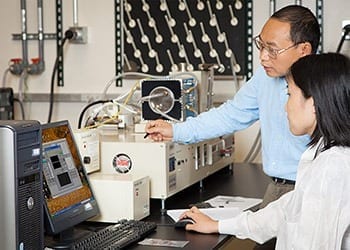
Surgeons at UC San Diego Health System have performed the region’s first robotic gastrectomy, a potentially lifesaving procedure to remove a section of the stomach after a diagnosis of gastric cancer.
Aided by a da Vinci robot, surgeons remove the diseased tissue, perform a delicate reconstruction and remove local lymph nodes for further testing.
“To treat the gastric cancer, we remove part or all of the stomach with five small incisions,” said Kaitlyn Kelly, MD, surgical oncologist at UC San Diego Health System. “The goal of the robotic approach is to remove the cancer and carefully extract nearby lymph nodes in a highly precise way to achieve a more accurate cancer staging.”
Kelly’s patient, a woman of Korean descent, was diagnosed with stomach cancer after reporting upper abdominal pain to her physician. Korean men and women are five to seven times more likely than Caucasians to develop gastric cancer, which is the fourth most common cancer worldwide.
Also known as an adenocarcinoma, stomach cancer arises from the mucus-producing cells of the stomach lining. Early detection and accurate staging are essential to the patient’s long-term survival. Staging describes the extent or severity of a person’s cancer. Patients with a diagnosis of gastric cancer typically complain of upper stomach pain, persistent and severe heartburn or stomach fullness shortly after eating.
“What is special about the robotic approach is the ability to carefully remove the lymph nodes around large blood vessels without causing damage to the nodes or vessels. This robotic approach can potentially offer a better specimen for pathologists to evaluate,” said Santiago Horgan, MD, chief of minimally invasive surgery at UC San Diego Health System and director of the Center for the Future of Surgery at UC San Diego School of Medicine.
Kelly added that minimally invasive surgery techniques, both robotic and laparoscopic, lead to a speedier recovery, which is important for cancer patients, many of whom require additional chemotherapy after surgery to complete their comprehensive cancer treatment.
Potential risks to this surgery include bleeding, abdominal hernia and leakage of gastric fluids into the abdomen. All potential risks and complications from robotic surgery should be discussed with one’s surgeon.
The Latest Bing News on:
Robotic Surgery
- AUA to Focus on Inclusive Care, Robotic Surgeries, and Future of Urology at 2024 Annual Meetingon April 30, 2024 at 5:00 pm
Meanwhile, other forums will tackle topics such as diversity, equity, and inclusion, as well as advancements in robotic surgery and novel therapies for various urological conditions. The meeting also ...
- SS Innovations Achieves Pediatric Milestone with First Infant Pyeloplasty Using SSi Mantra Surgical Robotic Systemon April 29, 2024 at 5:47 am
SS Innovations International, Inc. (the “Company” or “SS Innovations”) (OTC: SSII), a developer of innovative surgical robotic technologies dedicated to making robotic surgery affordable and ...
- Fredericksburg robotic surgeon hits major milestone of 1,500 caseson April 28, 2024 at 5:00 pm
Thomas is a practiced hand at this type of operation with high-dollar and high-tech instruments. In less than 10 years, he’s performed more than 1,500 such surgeries, including almost 200 locally ...
- Local robotic surgeon hits major milestone of 1,500 caseson April 28, 2024 at 2:02 am
They decided to move things up a decade or so, and searched for a position — where he could again do robotic surgery — in the Commonwealth. He and his wife picked Spotsylvania Regional Medical Center, ...
- Hyderabad: Sudanese national undergoes robotic surgery at Medicoveron April 27, 2024 at 6:15 am
The blood loss was very minimal. Post-operatively, the patient recovered well from renal failure as the obstruction for both the ureters was relieved.
- ‘Sciatica was gone’: hospital performs robot-assisted spinal surgery in Canadian firston April 26, 2024 at 6:08 am
London Health Sciences Centre was home to the first ever robot-assisted direct lateral spinal surgery in Canada. Dave Meyn said when he woke up from surgery, the sciatic was gone.
- Hartford HealthCare unveils latest in robotic innovation for prostate cancer careon April 24, 2024 at 10:10 am
For the last two decades, robotic surgery has been a game changer for the treatment of prostate cancer. Hartford HealthCare’s Tallwood Urology & Kidney Institute is now bringing the latest in robotic ...
- We are leading experts in robotic surgeryon April 23, 2024 at 6:21 am
Robotic surgery delivers a faster recovery, especially when time is of the essence. When Ginny Ross was diagnosed with uterine cancer, she chose to have a total hysterectomy with Dr. Bradley Corr, an ...
- Mercy Hospital surgeon teaches high school students world of robotic surgeryon April 20, 2024 at 10:37 pm
A unique experience for high school students, taking a step into the world of robotic surgery. Mercy Hospital hosted students to learn the ins and outs of the future of surgical medicine.
- Medtronic unveils new AI for laparoscopic, robotic surgery techon April 18, 2024 at 6:00 am
Medtronic (NYSE: MDT) today announced new AI capabilities to go with the launch of its Touch Surgery Live Stream digital offering.
The Latest Google Headlines on:
Robotic Surgery
[google_news title=”” keyword=”Robotic Surgery” num_posts=”10″ blurb_length=”0″ show_thumb=”left”]
The Latest Bing News on:
Robot Surgery
- How to build and protect skills in our modern workplace, a world filled with AI and robotson May 1, 2024 at 12:22 pm
Researcher and technologist Matt Beane, an assistant professor in the Technology Management Department at UC Santa Barbara, is calling attention to an immediate and hidden concern in the modern ...
- Dutch startup to bring robotic blood drawing to hospitalson May 1, 2024 at 8:48 am
Since 2023, Vitestro is running the world’s largest-scale clinical trial for autonomous blood drawing devices in collaboration with hospitals and medical centres in the Netherlands.
- AUA to Focus on Inclusive Care, Robotic Surgeries, and Future of Urology at 2024 Annual Meetingon April 30, 2024 at 5:00 pm
Meanwhile, other forums will tackle topics such as diversity, equity, and inclusion, as well as advancements in robotic surgery and novel therapies for various urological conditions. The meeting also ...
- New robot at Sharp lets doctors get better 'feel' for surgeryon April 30, 2024 at 10:07 am
A new robot at Sharp Hospital in San Diego lets doctors "feel" the patient as they operate from a console. It also makes recovery times faster. ABC 10News Anchor Jared Aarons reports.
- Fredericksburg robotic surgeon hits major milestone of 1,500 caseson April 28, 2024 at 5:00 pm
Thomas is a practiced hand at this type of operation with high-dollar and high-tech instruments. In less than 10 years, he’s performed more than 1,500 such surgeries, including almost 200 locally ...
- Local robotic surgeon hits major milestone of 1,500 caseson April 28, 2024 at 2:02 am
They decided to move things up a decade or so, and searched for a position — where he could again do robotic surgery — in the Commonwealth. He and his wife picked Spotsylvania Regional Medical Center, ...
- ‘Sciatica was gone’: hospital performs robot-assisted spinal surgery in Canadian firston April 26, 2024 at 6:08 am
London Health Sciences Centre was home to the first ever robot-assisted direct lateral spinal surgery in Canada. Dave Meyn said when he woke up from surgery, the sciatic was gone.
- LHSC performs a Canadian first in robot-assisted direct lateral spine surgeryon April 25, 2024 at 7:40 am
Earlier this year, London Health Sciences Centre (LHSC) became the first hospital in Canada to perform robot assisted direct lateral spine surgery. The patient was London, Ont. resident Dave Meyn, now ...
- Hartford HealthCare unveils latest in robotic innovation for prostate cancer careon April 24, 2024 at 10:10 am
For the last two decades, robotic surgery has been a game changer for the treatment of prostate cancer. Hartford HealthCare’s Tallwood Urology & Kidney Institute is now bringing the latest in robotic ...
- We are leading experts in robotic surgeryon April 23, 2024 at 6:21 am
Robotic surgery delivers a faster recovery, especially when time is of the essence. When Ginny Ross was diagnosed with uterine cancer, she chose to have a total hysterectomy with Dr. Bradley Corr, an ...
The Latest Google Headlines on:
Robot Surgery
[google_news title=”” keyword=”Robot Surgery” num_posts=”10″ blurb_length=”0″ show_thumb=”left”]










